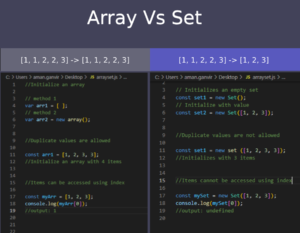1. Introduction
The two most common types of data structures to be used in programming are arrays and sets. They may seem to be the same, but in terms of their properties and abilities there are distinct differences. To optimize their code and make it work better, developers need to understand these differences.
We’ll be comparing arrays and sets on the blog, detailing their specific features as well as case studies. We will examine the benefits and disadvantages of each data type, to help you make informed choices about which arrays or sets are used within your programming projects by means of real-life examples and Practical explanations. Let’s go into arrays and sets to find out the secrets!
2. The Purpose and Structure of Arrays
Arrays are a popular data structure for programming, which enables you to store and organize different values of an identical type. They’re sized in a fixed order, which means that elements are stored in a set of sequences where they can be accessed using their index. This property allows you to retrieve the values from arrays in an efficient manner.
For situations in which elements need to be accessed and manipulated separately, arrays are especially useful. In cases where the ability to rapidly search for specific elements is critical to optimize performance, they are frequently employed as sorting and finding algorithms.
As far as structure is concerned, arrays consist of a continuous block of memory that can hold an unlimited number of elements. Each element is allocated a specific amount of memory according to its type, which will lead to an effective management of the memory.
We’ll be looking at the purpose and structure of sets as a further significant data structure for programming this next section. You’ll find out more about sets and how they differ from arrays.
3. The Purpose and Structure of Sets
In programming, sets are another format of data which is used for a different purpose than arrays. While arrays are intended to store and organize multiple values of the same type, sets contain a variety of unique elements that can be stored.
A set does not have a fixed size or a specific order, unlike arrays. In contrast, they focus on uniqueness and offer methods to efficiently check that an element is present or deleted from the set. In such cases, sets are a good fit for scenarios where the order of elements is not important and special values need to be kept.
As regards structure, different data structures such as hash tables, binary search trees or linked lists can be used to implement a set. In terms of the time complexity of operations such as insertion, deletion, and search, each implementation has its advantages and disadvantages.
We will take a deeper look at the operation and use cases of sets in this next section, providing an insight into how they differ from arrays. We’ll keep you updated on the world of sets in programming.
4. Array vs. Set: Performance and Efficiency Comparison
Let’s look at the performance and efficiency of arrays, now that we understand how to distinguish between arrays and sets.
The array size is fixed, which means that when you need to expand an array it can be expensive to add or remove items. You must create a new array with a larger size and copy all the elements to it to refresh the array. Adding or removing elements from the middle of an array might also be ineffective, as it requires a change in all other elements to take place.
On the other hand, sets do not have a fixed size, which makes it easy to add and remove them. It will be automatically checked for uniqueness and added only if there are no existing ones when you add an element to a set. This uniqueness check ensures that the set retains its unique character and does not require any other operations.
Additionally, sets have built-in methods for efficiently checking if an element is present. This makes them suitable for scenarios where rapid membership testing is required, such as filtering unique values from a large dataset.
In terms of time complexity, arrays generally have better performance for random access operations since they provide the ability to directly access elements using their indices. Sets, on the other hand, excel in operations that involve searching or adding/removing elements.
Overall, the choice between arrays and sets depends on the specific requirements of your program. If you need an ordered and fixed-size collection, arrays might be the way to go. However, if you prioritize uniqueness and efficient addition/removal operations, sets offer a more optimized solution.
Stay tuned for the next section where we will discuss real-world use cases and examples of when to use arrays versus sets in programming.
5. Array vs. Set: Use Cases and Applications
In this section, we will delve into the various use cases and applications where arrays and sets excel in programming. Understanding these practical scenarios will help you make an informed decision on when to use arrays versus sets in your programs.
- Arrays
-
- Arrays are commonly used when you require a collection of items that need to be accessed randomly using their indices. This makes arrays suitable for scenarios such as:
- To store and manipulate tabular data, such as database or a spreadsheet table where each row represents an item, while each column is its own property.
- when elements are added or removed in a particular pattern, the implementation of data structure like stacks and queues is carried out.
- Sorting algorithms, as arrays provide efficient random access for comparison-based sorting methods.
- Arrays are commonly used when you require a collection of items that need to be accessed randomly using their indices. This makes arrays suitable for scenarios such as:
- Sets
-
- Sets are ideal for scenarios that involve maintaining a collection of distinct elements and performing operations based on unique values. The most common use cases for sets are:
- Removing duplicates from a large dataset, as sets automatically enforce uniqueness and eliminate the need for additional operations.
- Finding common or distinct elements between multiple collections in the form of sets offers built-in methods for set operations such as intersection, union, and difference.
- Implementing algorithms that require efficient membership testing, such as finding if a specific value exists in a large dataset without having to traverse the entire collection.
- Sets are ideal for scenarios that involve maintaining a collection of distinct elements and performing operations based on unique values. The most common use cases for sets are:
6. Key considerations in deciding between arrays and sets
A number of important factors need to be taken into account when selecting arrays and sets for your programming needs. You will be able to make a good choice, which is the most appropriate for your needs, by taking account of those considerations.
- Performance: Choose arrays when you need fast random access to elements, as arrays provide constant time access based on indices. On the contrary, when you need an efficient membership test or if you want to perform specific operations like searching for shared or differentiated elements, a set is ideal.
- Duplicate Elements: If your program requires the removal of duplicates from a collection, sets offer the advantage of automatically enforcing uniqueness. Arrays can also handle duplicate elements, but you would need to manually implement additional logic to remove duplicates.
- Ordering: Arrays preserve the order of elements, making them suitable for scenarios like sorting algorithms or data structures that rely on specific orders. On the other hand, sets do not give any particular order of elements as they are dependent on a specific value.
- Memory Efficiency: In order to maintain uniqueness, sets are typically requiring more memory than arrays because of their different data structures. A more appropriate choice might be arrays if memory usage is an issue.
By carefully considering these factors, you can confidently choose between arrays and sets in your programming projects.
Example :-

The elements are not stored in a specific order within this set, and duplicates are automatically deleted. You can’t access elements with an index, but you can perform set operations such as checking for containment, adding and removing elements, and performing set operations such as union, intersection, and difference. In this example, the main difference is that arrays retain order of elements and allow duplication whereas sets do not keep order at all.
7. Conclusion: Making a decision with a clear understanding
In conclusion, understanding the differences between arrays and sets is crucial for making informed programming decisions. By considering factors such as performance, handling duplicate elements, ordering, and memory efficiency, you can choose the most suitable data structure for your specific requirements.
Arrays are beneficial when you need fast random access to elements, preserve the order of elements, and have lower memory usage. On the other hand, sets are ideal for efficient membership testing, performing set operations, and automatically enforcing uniqueness.


Nice informative blog.